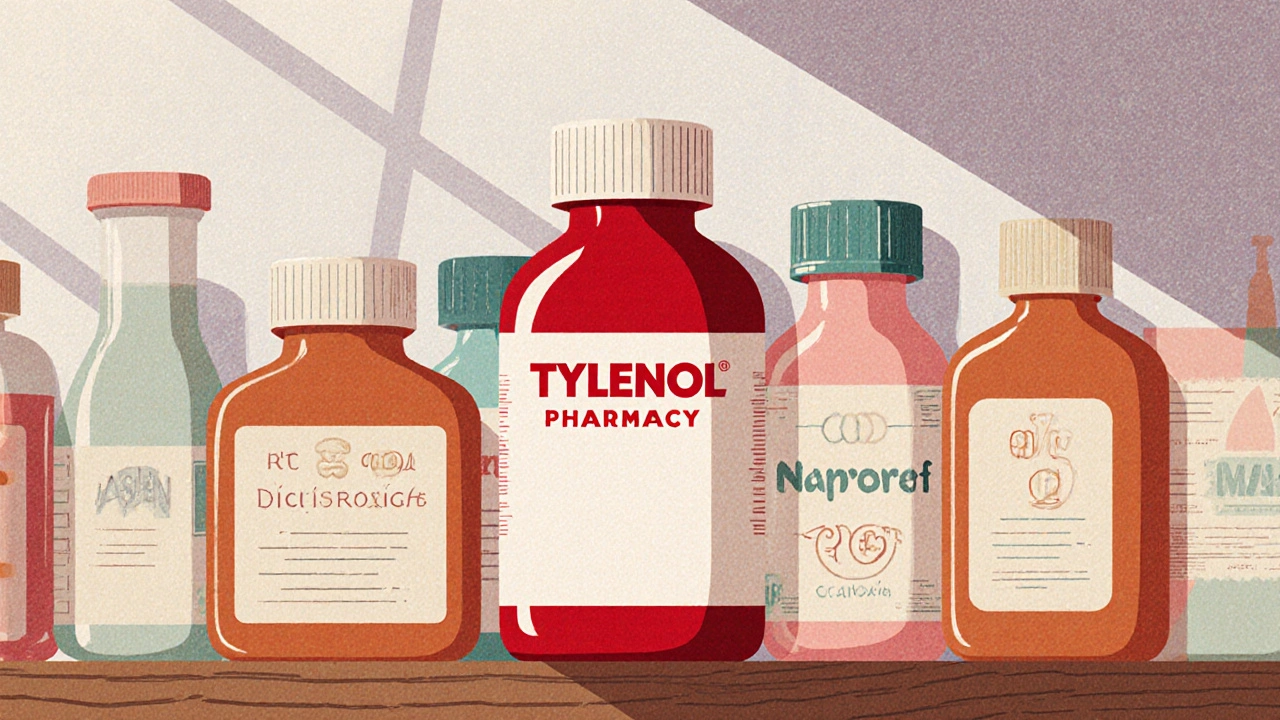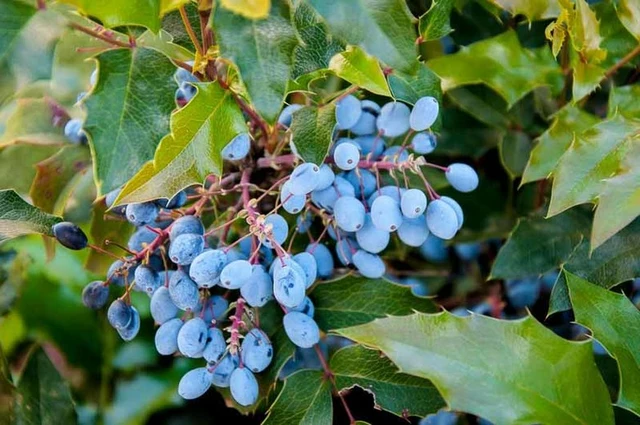Tylenol vs Pain Reliever Alternatives: Detailed Comparison
When you reach for a pain reliever, Tylenol is the flagship brand of acetaminophen, an over‑the‑counter analgesic and antipyretic. It’s the go‑to for many when a headache or fever strikes, but dozens of alternatives sit on pharmacy shelves, each with its own strengths and trade‑offs. This guide walks through the most common substitutes, outlines when each shines, and gives you a practical checklist to pick the right one for your needs.
Quick Takeaways
- Tylenol (acetaminophen) is best for fever and mild‑to‑moderate pain when you need a non‑NSAID option.
- Ibuprofen and naproxen are stronger anti‑inflammatories but can irritate the stomach and affect kidneys.
- Aspirin adds blood‑thinning benefits but isn’t ideal for children or anyone with ulcers.
- Diclofenac and celecoxib are prescription‑strength NSAIDs for chronic joint pain, usually reserved for arthritis.
- Always match the drug to your health profile-liver health, heart risk, and stomach sensitivity matter.
How Tylenol Works
Acetaminophen blocks a specific enzyme in the brain called COX‑3, which reduces the perception of pain and helps reset the body’s temperature set point. It doesn’t have significant anti‑inflammatory activity, so it won’t swelling like a typical NSAID. The drug is metabolized in the liver, and most people tolerate the standard 325‑1000 mg dose without issues. However, exceeding 4 g in a day can overload the liver and cause serious injury.
Common Alternatives at a Glance
Below are the top over‑the‑counter (OTC) and prescription choices you’ll see on store shelves or in a doctor’s office.
Ibuprofen is an NSAID that reduces pain, fever, and inflammation by inhibiting COX‑1 and COX‑2 enzymes.
Aspirin (acetylsalicylic acid) also blocks COX enzymes, adds antiplatelet effects, and is often used for heart‑health prevention.
Naproxen is a longer‑acting NSAID, popular for musculoskeletal pain and arthritis.
Diclofenac is a prescription NSAID that’s especially effective for joint inflammation.
Celecoxib is a COX‑2 selective NSAID, designed to spare the stomach while delivering strong anti‑inflammatory relief.
Side‑Effect Profile Overview
All pain relievers carry some risk. Understanding the main side‑effects helps you avoid complications.
- Liver toxicity: Primarily a concern with acetaminophen (Tylenol) at high doses or when combined with alcohol.
- Stomach irritation and ulcers: Common with non‑selective NSAIDs like ibuprofen, naproxen, and aspirin.
- Kidney strain: NSAIDs can reduce blood flow to the kidneys, especially in dehydration or pre‑existing kidney disease.
- Bleeding risk: Aspirin’s antiplatelet action increases bleeding risk; celecoxib has a lower risk but still warrants caution in certain heart‑disease patients.
Comparison Table
| Drug | Pain Relief | Anti‑Inflammatory | Fever Reduction | Typical OTC Dose | Onset | Duration | Major Side‑Effects |
|---|---|---|---|---|---|---|---|
| Tylenol (Acetaminophen) | Moderate | None | Strong | 325‑1000 mg every 4‑6 h (max 4 g/24 h) | 30‑60 min | 4‑6 h | Liver toxicity (overdose), rare rash |
| Ibuprofen | Moderate‑Strong | Moderate | Good | 200‑400 mg every 6‑8 h (max 1.2 g/24 h) | 15‑30 min | 6‑8 h | Stomach upset, ulcer risk, kidney strain |
| Aspirin | Moderate | Moderate | Good | 325‑650 mg every 4‑6 h (max 4 g/24 h) | 15‑30 min | 4‑6 h | Bleeding, stomach irritation, Reye’s syndrome in children |
| Naproxen | Strong | Strong | Good | 220‑440 mg every 8‑12 h (max 660 mg/24 h) | 30‑60 min | 8‑12 h | Stomach ulcer, kidney strain, cardiovascular risk |
| Diclofenac | Strong | Strong | Modest | Prescription - 50‑150 mg 2‑3 times daily | 15‑30 min | 6‑8 h | Liver enzyme elevation, cardiovascular events, ulcer risk |
| Celecoxib | Strong | Strong (COX‑2 selective) | Modest | Prescription - 100‑200 mg daily | 30‑60 min | 12‑24 h | Elevated blood pressure, heart‑failure risk, less GI upset |
Choosing the Right Agent for Your Situation
Below are common scenarios and the drug that usually fits best.
- Fever in a child under 12: Stick with acetaminophen. Aspirin is contraindicated due to Reye’s syndrome, and NSAIDs can be harsher on a young liver.
- Back pain with swelling: An NSAID like ibuprofen or naproxen tackles both pain and inflammation. If you have a history of ulcers, consider a COX‑2 selective option like celecoxib (prescription).
- Post‑surgery pain where bleeding is a concern: Avoid aspirin and high‑dose NSAIDs. Acetaminophen provides analgesia without affecting clotting.
- Chronic arthritis requiring daily relief: Discuss prescription NSAIDs (diclofenac, celecoxib) with a doctor. They offer sustained control but need monitoring.
- Liver disease or heavy alcohol use: Skip acetaminophen. Opt for the lowest effective NSAID dose, but watch kidney function.
- Cardiovascular risk (e.g., hypertension): Prefer acetaminophen or a low‑dose COX‑2 selective NSAID under supervision; non‑selective NSAIDs can raise blood pressure.
Safety Tips and Drug Interactions
Regardless of the choice, keep these rules in mind:
- Never combine multiple acetaminophen‑containing products (e.g., Tylenol + some cold medicines) - the dose adds up.
- Alcohol amplifies liver toxicity of acetaminophen and can increase stomach bleeding with NSAIDs.
- Warfarin or other anticoagulants plus aspirin or high‑dose NSAIDs dramatically raise bleeding risk.
- Check kidney function labs if you need daily NSAID use for more than a week.
- Pregnant women should generally avoid NSAIDs in the third trimester; acetaminophen is considered safer.

Practical Checklist Before You Buy
- Identify your primary symptom: pain, fever, or inflammation?
- Review health conditions: liver disease, ulcer history, heart disease, kidney issues.
- Check other medications for overlapping ingredients or interaction risks.
- Decide on OTC vs prescription: chronic joint pain may need a doctor’s script.
- Read the label for maximum daily dose and warning statements.
- Store the medication away from children and at room temperature.
Bottom Line
Tylenol remains the safest bet for fever and mild pain when you need a non‑NSAID option, especially for children or people with stomach sensitivity. Ibuprofen and naproxen step in when inflammation is part of the problem, but they demand a clean stomach and good kidney health. Aspirin’s blood‑thinning edge is useful for heart‑health patients but is off‑limits for most kids. Prescription NSAIDs like diclofenac and celecoxib reserve power for chronic joint conditions, requiring doctor oversight.
Frequently Asked Questions
Can I take Tylenol and ibuprofen together?
Yes, short‑term alternating doses can give stronger pain relief while keeping each drug below its maximum daily limit. Always space them at least 3‑4 hours apart and talk to a pharmacist if you have chronic conditions.
Why is acetaminophen considered safer for the stomach?
Acetaminophen does not inhibit COX‑1, the enzyme that protects the stomach lining. Therefore it doesn’t cause the irritation or ulcer risk that classic NSAIDs do.
Is aspirin still recommended for heart‑attack prevention?
Low‑dose aspirin (81 mg) is still used in many guidelines, but recent studies suggest the benefit may be limited for people without prior cardiovascular events. Always follow a doctor’s advice.
What should I do if I accidentally exceed the acetaminophen limit?
Seek emergency care immediately. Early treatment with N‑acetylcysteine can prevent serious liver damage, but timing is critical.
Can I use NSAIDs while pregnant?
Avoid NSAIDs in the third trimester because they can affect fetal kidney development and prolong labor. Acetaminophen is generally safer throughout pregnancy, but check with your OB‑GYN.







10 Comments
Ayla Stewart
October 18, 2025 at 13:02
I find the checklist especially handy. It reminds me to look at liver health before stacking acetaminophen doses. Keeping a quick note on the label can prevent accidental overdose.
Poornima Ganesan
October 20, 2025 at 21:53
Honestly, most people don’t read the fine print on pain meds, and that’s where the trouble starts. The guide tries to be neutral, but it glosses over the fact that NSAIDs can silently damage kidneys, especially in older adults. If you’re taking ibuprofen for a week, you should already be checking your creatinine levels – that’s basic medical hygiene. Moreover, the author forgets to mention that combining acetaminophen with alcohol is a recipe for liver disaster. In short, the “quick takeaways” are way too vague for anyone who actually cares about safety.
Norman Adams
October 23, 2025 at 06:50
Because we all love liver failure, right?
Margaret pope
October 25, 2025 at 15:46
Switching to acetaminophen after surgery is smart it avoids the bleeding risk that comes with aspirin. It also spares the stomach from the ulcer‑forming effects of NSAIDs. Just make sure to stay under the daily limit.
Linda A
October 27, 2025 at 23:43
When we consider pain, we are confronting the fragile boundary between the body’s signals and the mind’s interpretation. Acetaminophen sits at that intersection, quieting the fire without stirring the storm of inflammation. It is a modest companion, not a hero, yet its subtlety is precisely what makes it valuable.
Joe Moore
October 30, 2025 at 08:40
People think the pharma giants just want you to feel better, but the real game is about keeping you hooked on cheap meds. They push ibuprofen and naproxen hard because those NSAIDs line their pockets with higher margins, while silently nudging you towards kidney trouble. And don’t even get me started on how “clinical trials” often hide long‑term liver data – it’s like a blackout that protects their profit. If you read between the lines, you’ll see the checklist is more of a marketing script than a neutral guide. Stay woke, read the actual drug label, and don’t trust the shiny tables.
Emma Williams
November 1, 2025 at 17:36
I think the table does a good job summarizing the options.
Stephanie Zaragoza
November 4, 2025 at 02:33
While the comparison table is comprehensive, it omits crucial pharmacokinetic details; for instance, the half‑life of celecoxib differs markedly from that of ibuprofen, which influences dosing intervals. Additionally, the author should have highlighted the contraindication of aspirin in patients with a history of gastrointestinal bleeding, a point that cannot be overstated. Finally, the checklist would benefit from a clear statement regarding the necessity of consulting a healthcare professional before initiating chronic NSAID therapy.
James Mali
November 6, 2025 at 11:30
Honestly, the guide feels over‑engineered for everyday use.
Janet Morales
November 8, 2025 at 20:26
What the article fails to admit is that the whole pain‑relief industry is built on a narrative of convenience over caution.
While it praises acetaminophen as the safe choice for fevers, it conveniently ignores the rising incidence of accidental overdoses among unsuspecting parents.
The suggestion that NSAIDs are merely “stronger” masks the fact that they unleash a cascade of hidden dangers that most users never see coming.
Stomach ulcers are just the tip of the iceberg; chronic kidney disease silently spreads in long‑term ibuprofen users.
And yet the guide tells you to alternate ibuprofen and Tylenol without mentioning the increased burden on the liver from hidden acetaminophen in cold medicines.
It also glosses over the reality that COX‑2 inhibitors, though marketed as gentle, have been linked to serious cardiovascular events.
If you read the fine print, you’ll discover that “prescription‑strength” is a euphemism for “watch your blood pressure and heart rhythm closely.”
The author’s checklist, while tidy, feels like a sales pitch masquerading as medical advice.
Patients with hypertension are told to consider celecoxib, yet the drug itself can elevate blood pressure further.
Pregnant women are warned against NSAIDs in the third trimester, but the guide neglects to stress that even short‑term use can affect fetal kidney development.
Furthermore, the piece fails to address the interaction between alcohol and acetaminophen, a lethal combo that costs lives daily.
The tone is reassuring, almost complacent, as if a simple pill can solve complex physiological issues.
In reality, each analgesic comes with a web of contraindications that deserve a deeper discussion.
The omission of these nuances betrays a bias toward promoting over‑the‑counter convenience.
Readers deserve a blunt warning: self‑medicate at your own risk, and never assume a one‑size‑fits‑all solution.
In short, before you reach for any of these drugs, ask yourself if you’re truly informed or merely following a polished pamphlet.